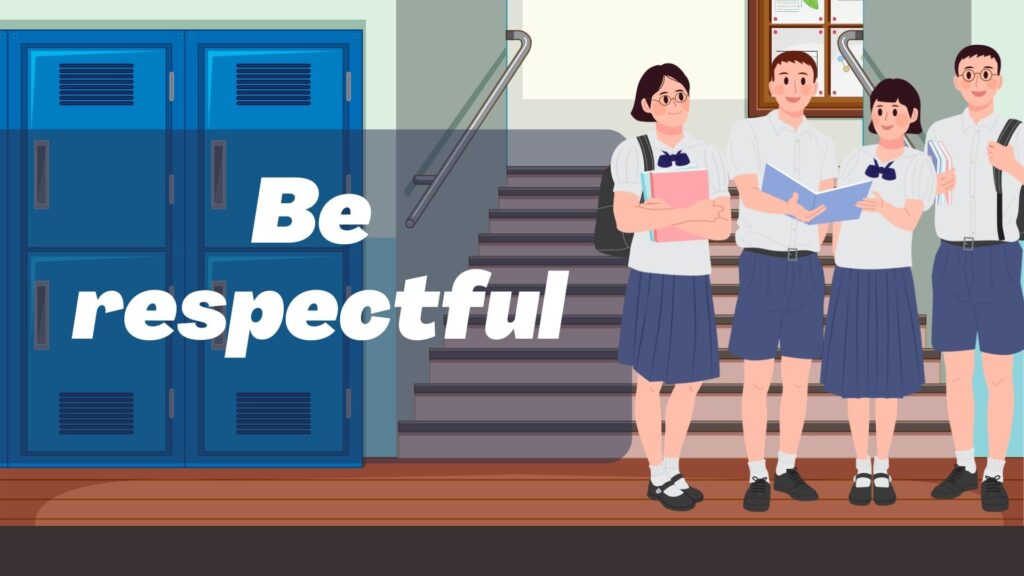
TRANSFORMING CLASSROOMS WITH HEART: Human-Centered Rules for Becoming the Best Student and Building a Thriving Learning Community".
Classroom rules are essential for establishing order, setting expectations, and creating a productive learning environment. However, traditional rules can sometimes feel rigid or authoritarian, leading students to follow them out of obligation rather than genuine understanding. When we infuse these rules with a human touch—empathy, respect, and kindness—we transform the classroom into a nurturing community where students feel valued, supported, and motivated to contribute positively.
This approach not only fosters academic success but also cultivates social and emotional growth, preparing students for life beyond the classroom.
1. Respect Everyone’s Voice: A Foundation of Mutual Respect
At the heart of every successful student is the principle of mutual respect. “Respect Everyone’s Voice” is more than just a rule; it’s a philosophy that values every student’s thoughts, feelings, and experiences. In practice, this means encouraging students to listen attentively when someone else is speaking, to refrain from interrupting, and to acknowledge different perspectives, even if they don’t agree with them.

Practical Applications:
- Talking Stick or Object : Use a talking stick or another object that the speaker holds, signaling their turn to speak. This simple practice can help younger students visualize the concept of turn-taking and respectful listening.
- Classroom Discussions : When facilitating discussions, intentionally call on students who haven’t spoken much to ensure diverse voices are heard. Acknowledge their contributions and link them to the ongoing conversation, showing that every input matters.
By emphasizing this rule, we teach students to value and respect each other’s contributions, fostering a sense of belonging and community. This not only enhances classroom dynamics but also equips students with essential communication skills for their future. “Transforming Classrooms with Heart: Human-Centered Rules for Becoming the Best Student and Building a Thriving Learning Community”
2. Support Each Other: Building a Community of Care
Classrooms are microcosms of the larger society, and promoting a culture of support and kindness is crucial. “Support Each Other” means creating an environment where students look out for one another, celebrate each other’s successes, and offer help when needed. It encourages them to view their peers not as competitors but as partners in thei learning journey.

Practical Applications
- Peer Assistance Programs : Establish peer assistance systems where students can volunteer to help classmates who may be struggling with certain subjects. This not only reinforces their understanding but also builds empathy and patience.
- Celebrating Achievements : Take time to acknowledge both academic and personal achievements of students, no matter how small. Create a “wall of success” where students can post their accomplishments, or have a weekly “shout-out” session to celebrate their efforts.
This rule nurtures a collaborative spirit, reducing instances of bullying and fostering a positive classroom climate. Students who feel supported are more likely to take risks in their learning and to reach out for help when they need it, knowing they are part of a caring community.
3. Be Mindful of Space and Time: Respecting Shared Environments
“Be Mindful of Space and Time” is a rule that encourages students to be considerate of their surroundings and of others’ needs. This encompasses everything from being punctual and keeping the classroom tidy to respecting personal space and noise levels. It teaches students that their actions, however small, can have a significant impact on the people around them.

Practical Applications:
- Classroom Responsibilities : Assign rotating roles such as “clean-up captain” or “timekeeper” to foster a sense of responsibility for maintaining the classroom environment.
- Personal Space Awareness Activities : Use exercises to help students understand personal space. For example, have them stand at arm’s length from each other and discuss how different people have different comfort levels.
Instilling mindfulness in students can have far-reaching effects beyond the classroom. They learn to be aware of their behavior, to respect shared spaces, and to appreciate the value of being considerate. This rule, infused with a human touch, encourages students to think about how they contribute to the community and how they can create a more harmonious environment. “Transforming Classrooms with Heart: Human-Centered Rules for Becoming the Best Student and Building a Thriving Learning Community”
4. Embrace Mistakes as Learning Opportunities: Fostering a Growth Mindset
One of the most important lessons we can teach students is that mistakes are not failures but stepping stones to growth. “Embrace Mistakes as Learning Opportunities” is a rule designed to reduce the fear of failure and to encourage a growth mindset. It’s about creating a safe space where students feel comfortable taking risks and learning from their experience.

Practical Applications:
- Mistake of the Week :Highlight a “mistake of the week” made by a famous person or historical figure and discuss how they overcame it. This normalizes mistakes and shows students that even great minds encounter setbacks.
- Reflection Journals : Have students keep reflection journals where they write about mistakes they made during the week and what they learned from them. This practice reinforces the idea that reflection is a crucial part of learning.
- When students are not afraid to make mistakes, they are more willing to engage deeply with the material, ask questions, and explore new ideas. This rule helps build resilience and self-confidence, qualities that are essential for lifelong learning and personal development.
5. Communicate Kindly: The Power of Positive Language
“Communicate Kindly” emphasizes the importance of using positive and respectful language in all interactions. It’s about teaching students to express themselves in a way that is both honest and considerate, recognizing the power of words to uplift or to harm. This rule is fundamental in creating a safe and supportive classroom environment.

Practical Applications:
- Role-Playing Scenarios : Use role-playing exercises to teach students how to navigate difficult conversations or disagreements respectfully. Discuss the impact of different types of language and body language on the receiver.
- Compliment Circles : Regularly practice “compliment circles” where students say something positive about the person next to them. This not only boosts morale but also teaches them to look for the good in others.
Teaching students to communicate kindly helps them build strong, positive relationships with their peers and adults. It also reduces conflict and creates a classroom atmosphere where students feel emotionally safe to express themselves. “Transforming Classrooms with Heart: Human-Centered Rules for Becoming the Best Student and Building a Thriving Learning Community”
6. Take Care of Ourselves and Each Other: Prioritizing Well-Being
The final rule, “Take Care of Ourselves and Each Other,” underscores the importance of mental, emotional, and physical well-being. It encourages students to be mindful of their health and to look out for the well-being of their classmates. This rule acknowledges that learning is holistic and that students perform best when they feel well and supported.

Practical Applications:
- Mindfulness and Relaxation : Incorporate short mindfulness exercises or relaxation techniques into the daily routine. This could be as simple as a few minutes of deep breathing or a guided visualization to help students manage stress and anxiety.
- Well-Being Check-Ins : Implement regular “well-being check-ins” where students can share how they’re feeling. Use mood meters or emotion charts to help them articulate their feelings, and provide support where needed.
This rule helps students develop self-awareness and empathy, key components of emotional intelligence. By prioritizing well-being, we acknowledge that education is not just about academic achievement but also about nurturing healthy, happy individuals.
Implementing These Rules: Strategies for Success
Successfully implementing these rules requires consistency, modeling, and reflection. Teachers need to consistently reinforce these expectations and model the behavior they wish to see. This might mean actively listening to students, admitting their own mistakes, or showing empathy in challenging situations.
Regular reflection is also key. Periodically review the rules with students, discussing what’s working and what might need to change. This collaborative approach empowers students and gives them ownership over the classroom culture.
In conclusion, classroom rules with a human touch go beyond mere compliance. They are about nurturing a community of learners who are respectful, kind, and resilient. By infusing these rules with empathy and understanding, we create a classroom environment where students are not only prepared to succeed academically but also to thrive as compassionate, thoughtful human beings. “Transforming Classrooms with Heart: Human-Centered Rules for Becoming the Best Student and Building a Thriving Learning Community”

READ MORE BLOG———–https://pedagogyedu.com/blog/
